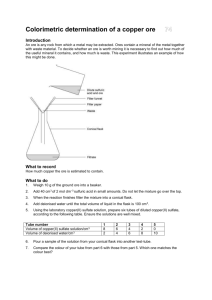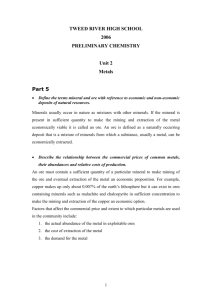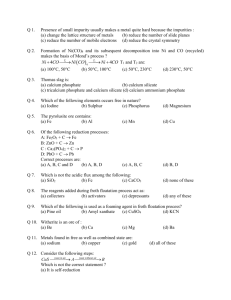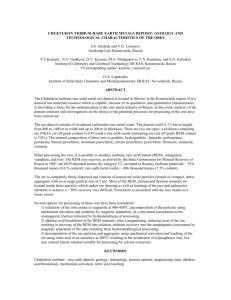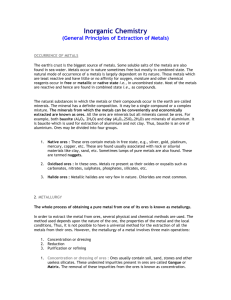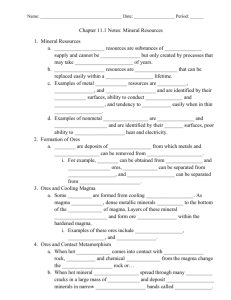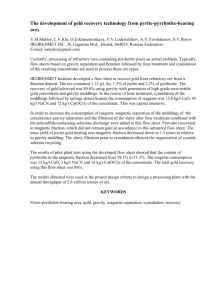Properties of Copper Ores
advertisement
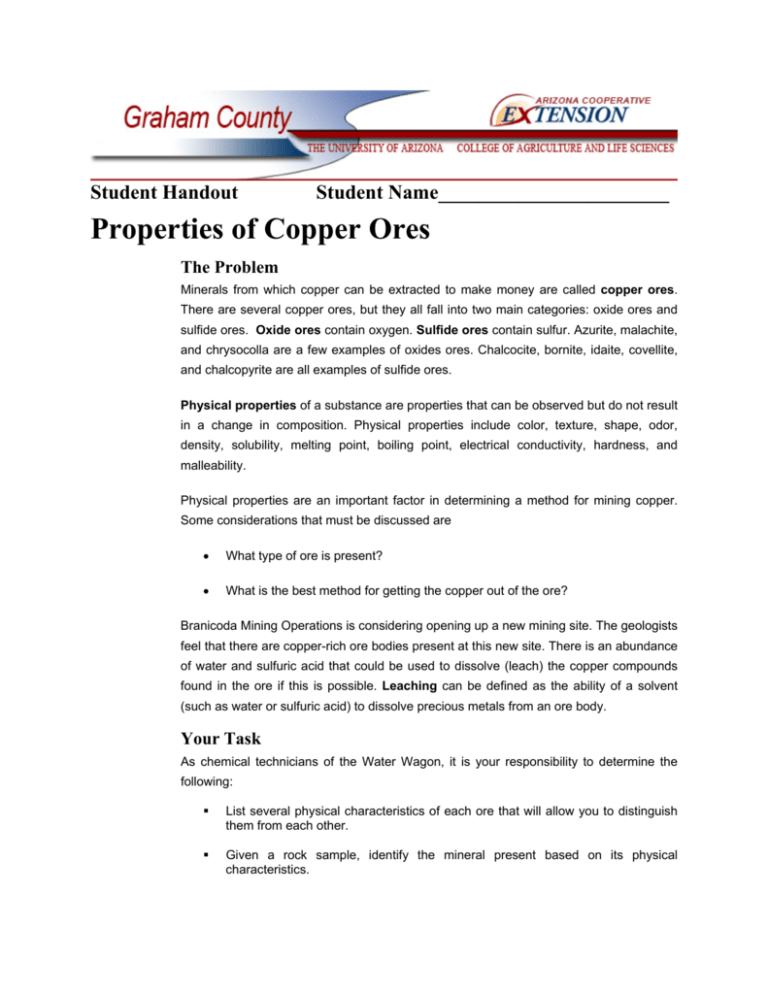
Student Handout Student Name_______________________ Properties of Copper Ores The Problem Minerals from which copper can be extracted to make money are called copper ores. There are several copper ores, but they all fall into two main categories: oxide ores and sulfide ores. Oxide ores contain oxygen. Sulfide ores contain sulfur. Azurite, malachite, and chrysocolla are a few examples of oxides ores. Chalcocite, bornite, idaite, covellite, and chalcopyrite are all examples of sulfide ores. Physical properties of a substance are properties that can be observed but do not result in a change in composition. Physical properties include color, texture, shape, odor, density, solubility, melting point, boiling point, electrical conductivity, hardness, and malleability. Physical properties are an important factor in determining a method for mining copper. Some considerations that must be discussed are • What type of ore is present? • What is the best method for getting the copper out of the ore? Branicoda Mining Operations is considering opening up a new mining site. The geologists feel that there are copper-rich ore bodies present at this new site. There is an abundance of water and sulfuric acid that could be used to dissolve (leach) the copper compounds found in the ore if this is possible. Leaching can be defined as the ability of a solvent (such as water or sulfuric acid) to dissolve precious metals from an ore body. Your Task As chemical technicians of the Water Wagon, it is your responsibility to determine the following: List several physical characteristics of each ore that will allow you to distinguish them from each other. Given a rock sample, identify the mineral present based on its physical characteristics. Properties of Copper Ores—Page 2 Determine if the copper-bearing mineral could be leached with water and/or 7.0 g/L H2SO4 (sulfuric acid). Materials Per lab team 50-mL of 7 g/L sulfuric acid (H2SO4) containing 10 g of chrysocolla in a closed container. 50-mL of 7 g/L sulfuric acid (H2SO4) containing 10 g of chalcopyrite in a closed container. 50-mL of 7g/L sulfuric acid (H2SO4) containing 10 g of chrysocolla in a closed container. 50-mL of 7g/L sulfuric acid (H2SO4) containing 10 g of malachite in a closed container. 50-mL of water containing 10 g of azurite in a closed container. 50-mL of water containing 10 g of chalcopyrite in a closed container. 50-mL of water containing 10 g of chrysocolla in a closed container. 50-mL of water containing 10 g of chalcopyrite in a closed container. 50-mL of water containing 10 g of malachite in a closed container. Rock samples of each ore (azurite, chalcopyrite, chrysocolla, and malachite) magnifier (not required but useful) Safety and Disposal As instructed by your teacher, follow appropriate safety procedures, including the use of personal protective equipment such as goggles and an apron. Use caution when working with 7-g/L sulfuric acid. This is a dilute solution, but should still be handled with caution. If spills occur, neutralize by sprinkling with baking soda and diluting with water. The 7-g/L sulfuric acid can be disposed of by neutralizing with 1 M sodium carbonate (Na2CO3) solution and flushed down the drain with 20-fold excess of water. Follow any additional disposal procedures as outlined by your instructor. Procedure 1. Obtain each of the following mineral samples: azurite, chrysocolla, malachite, and chalcopyrite from the instructor. Properties of Copper Ores—Page 3 2. Note the physical appearance of each sample, paying close attention to color, clarity, and any other distinguishing characteristics. Record your observations. Azurite ____________________________________________________________________ Chalcopyrite________________________________________________________________ Chrysocolla _________________________________________________________________ Malachite ___________________________________________________________________ 3. Look at the labels on each of the ore containers to find the chemical formula. Write the chemical formula for the three oxide ores and for the sulfide ore. Oxide Ores Formula Azurite Sulfide Ore Formula Chalcopyrite Chyrsocolla Malachite 4. What is the difference between an oxide ore and a sulfide ore? ______________________________________________________________________ ______________________________________________________________________ 5. Observe the containers containing chrysocolla and chalcopyrite in water. Record your observations. Ores Samples in Water Observations Azurite Chyrsocolla Chalcopyrite Malachite Q1: Do you feel that any of the ores could be leached with water? (Refer to the definition of leaching in the introduction.) Explain why or why not. ______________________________________________________________________ ______________________________________________________________________ Properties of Copper Ores—Page 4 6. Observe the containers containing the ore samples in sulfuric acid (H2SO4). Record your observations. Ores Samples in Observations Sulfuric Acid Azurite Chyrsocolla Chalcopyrite Malachite Q2: Do you feel that any of the ores could be leached with sulfuric acid? Explain why or why not. ______________________________________________________________________ ______________________________________________________________________ ______________________________________________________________________ Assessment Obtain an unknown ore sample from the instructor. Based on your previous observations, record the name and formula of the unknown ore sample. Name : ________________________________Formula: _____________________________ ________________________ Using Chemistry to Enhance the Chemical Workforce in the Innovative Age, NSF Grant Number 0101400 by Dr. Phil McBride, Science and Allied Health Division, Eastern Arizona College, Thatcher, Arizona. Research Advisor: Mickey Sarquis, Councilor 2004-06, American Chemical Society Division of Chemical Education; Director, Center for Chemistry Education; Professor, Dept. of Chemistry & Biochemistry, Miami University Middletown, Middletown, OH. 1/05
